Commissioned By
- Fundación Comité de Solidaridad con los Presos Políticos (CSPP)
Additional Funding
- OSUN Center for Human Rights & the Arts at Bard College
- Fundación Comité de Solidaridad con los Presos Políticos (CSPP)
- Porticus
Collaborators
- Cerosetenta
This investigation marks the launch of Plano Negativo, a new Forensic Architecture research unit based in Colombia.
Esta investigación marca el lanzamiento de la Unidad de Investigación de FA de Colombia, Plano Negativo.
El texto en Español sigue abajo.
On 23 November 2019, during some of largest anti-government demonstrations in Colombia for decades, 18-year-old protester Dilan Cruz was shot in Bogotá by an officer of the Colombian national riot police unit, Escuadrón Móvil Antidisturbios (ESMAD). The national strike in which Dilan was participating had been called to protest the conservative policies of then-president Ivan Duque, and his government’s lack of commitment to upholding the 2016 peace agreement, which was intended to bring an end to Colombia’s decades-long war. Dilan was shot in the head with a bean bag round—a form of ammunition that has been labelled ‘non-lethal’ and is used against protests throughout the world. He sustained severe head trauma and succumbed to his injuries in the hospital two days later.
The fatal event was captured by the cameras of witnesses, journalists and human rights defenders, as well as a CCTV camera located near to the scene. These videos were initially analysed by various news and media outlets, including by 070, Newsy, and Bellingcat, and by Noticias Uno. Their analyses identified the officer who shot Dilan as Captain Manuel Cubillos, and established the sequence of events leading up to the shooting. However, these findings were discredited by the Colombian Attorney General’s office when it began to evaluate the evidence for the legal case. The Attorney General’s office claimed that the news organisations lacked key visual materials to support the allegations.
The Strategic Center for Evidence Assessment (CEVAP), responsible for providing technical evidentiary support for the Attorney General’s office, conducted an analysis of the event using the available videos and a 3D scan of the scene. They claim that Dilan was not the intended target of the shot, citing an absence of supporting evidence. Instead, they concluded that Captain Cubillos fired toward a ‘mob’ of protesters that posed a threat to the police, and that Dilan crossed into the line of fire that was intended to subdue this so-called mob.
Our investigation reaches the opposite conclusion. By situating the same videos gathered as evidence for the legal case within a 3D model and applying a series of advanced methods of visual and spatial analysis, we can reveal that there is no shortage of visual evidence available to support the thesis that Dilan was the intended target of Cubillos, rather than the ‘mob’. We demonstrate how Captain Cubillos tracked Dilan Cruz’s movements with his weapon before taking the shot. Spatial-temporal synchronisation of audiovisual material allowed us to establish a correlation between Dilan’s movement and that of Captain Cubillos as he raises his weapon.
Our central method of analysis was the three-dimensional digital reconstruction of the event. Drawing on the available visual materials, we situated the different cameras within the model. We then analysed each cameras’ perspective to reconstruct the movement and position of each object and person in space and time at various points throughout the incident. We reproduced the movements of police officers, civilians, and relevant objects in precise detail, ensuring geo-temporal accuracy based on the videographic records.
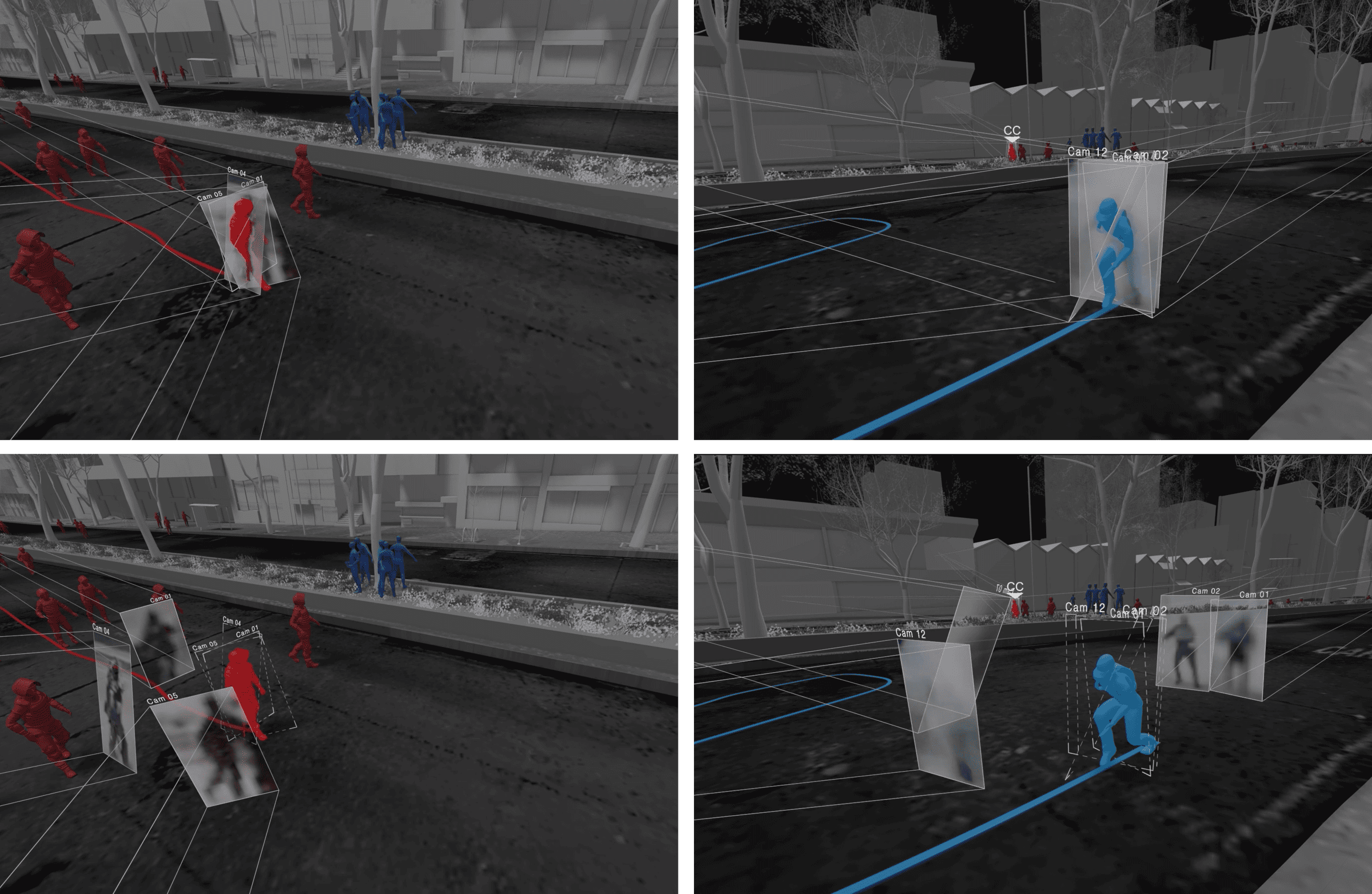
Our method differs substantially from that applied by CEVAP, who claimed that they had undertaken a 3D analysis of the crime scene. However, when our researchers requested this analysis, the Attorney General’s response was that this supposed 3D reconstruction was never executed, arguing that it was not necessary given the availability of video evidence. Instead, they used two-dimensional diagrams to locate different actors and objects based on screenshots taken from the videos, leading to an inaccurate and imprecise analysis.
We also analysed the technical conditions of the audiovisual recordings gathered and showed that CEVAP failed to consider these conditions when conducting their work. Factors such as the distance between the lens and the object, the type of camera, and perspective influence both what is recorded and the way in which it is presented as an image. Seconds before Cubillos shot Dilan, he threw two tear gas canisters down Calle 19 (19th Street). Using the perspective of a single camera, CEVAP concluded that the tear gas canisters thrown by Dilan Cruz fell very close to a group of ESMAD officers, constituting a threat that authorised the use of non-lethal weapons.
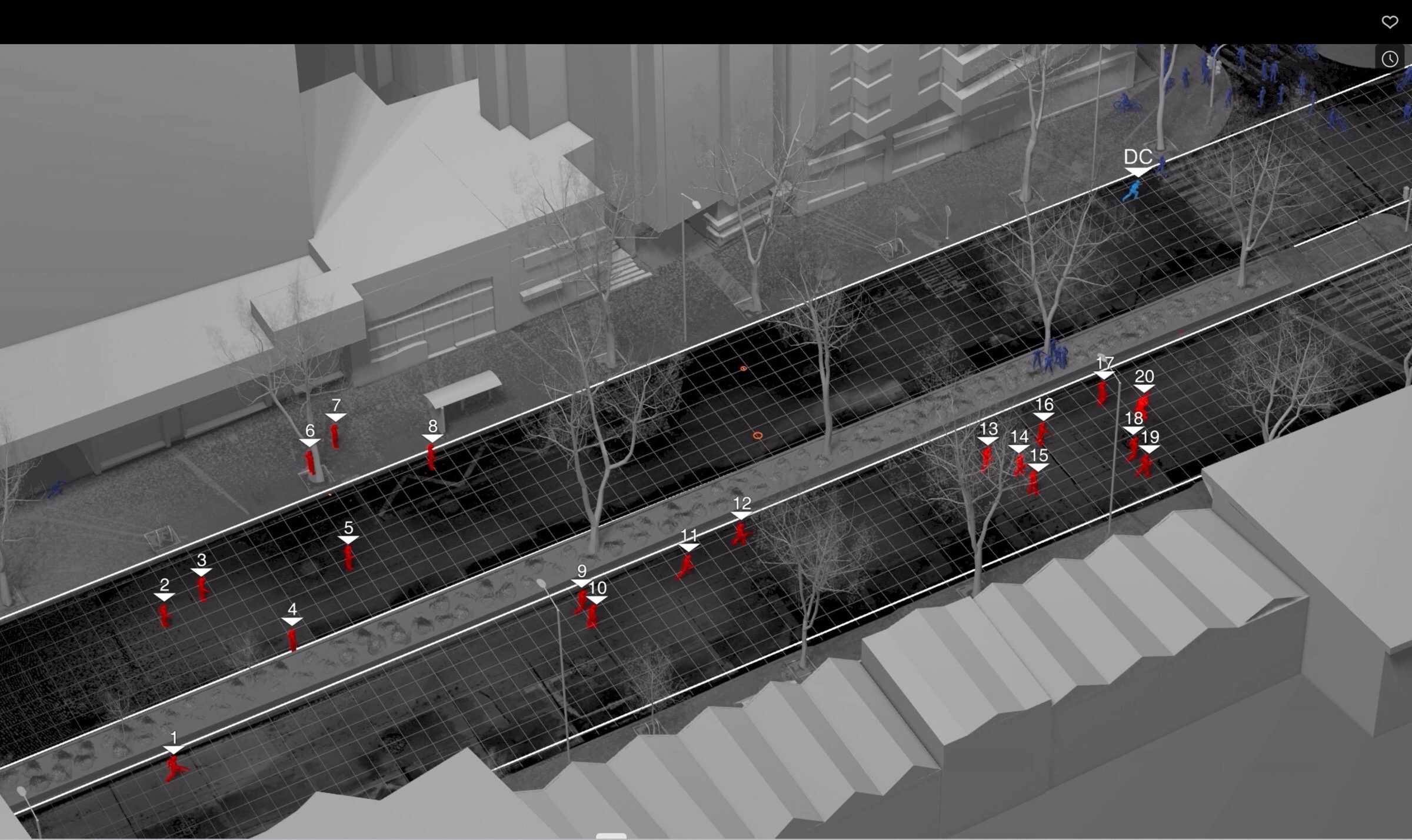
However, once we placed this camera in the 3D model, allowing us to cross-reference it with different cameras and measure the distance from the tear gas canister to the ESMAD agents, we discovered that it had been a full 27 metres away. We argue that CEVAP’s failure to take into consideration the technical conditions of the recordings and the interaction between different visual perspectives renders their analysis and understanding of the event inadequate.
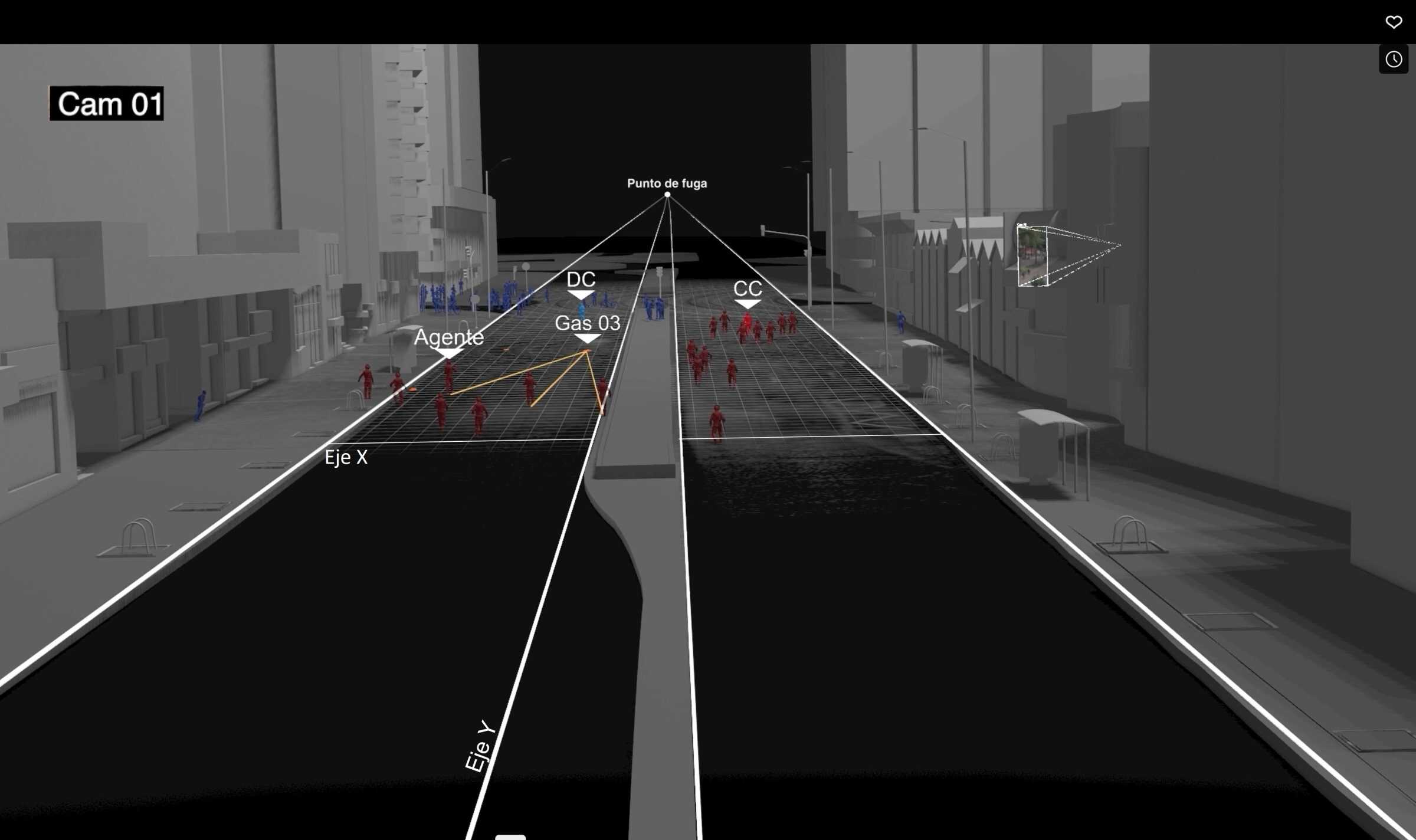
Intentionality
The second part of our investigation analyses the moment of the shot. We examine the four steps that Cubillos took before firing his weapon. Our analysis of the relationship between Cubillos’ and Dilan’s movements during these steps indicates that Dilan was the most likely target of the shot fired.
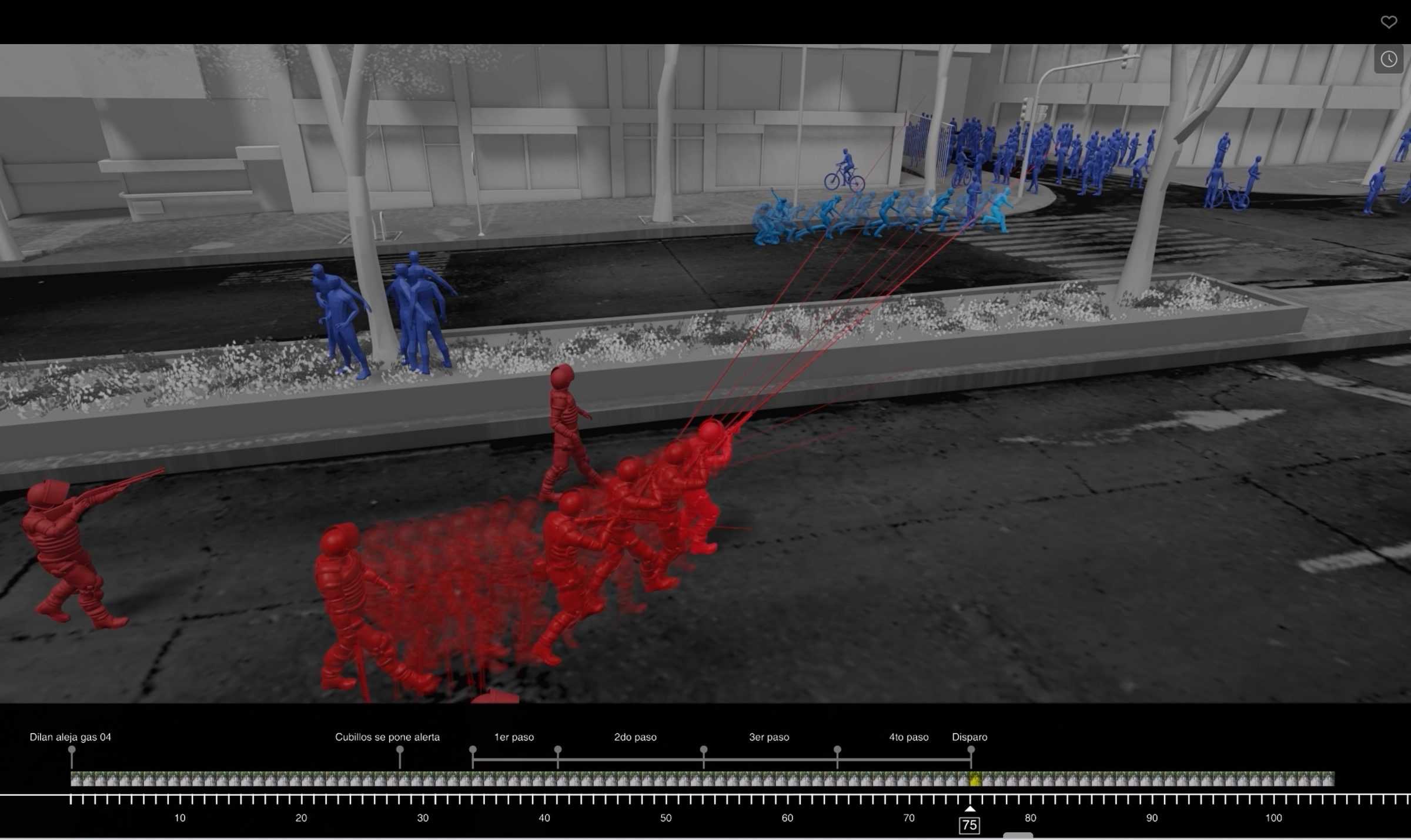
The sequence of events in between the moment Dilan returned the second tear gas canister until Cubillos fired his weapon was recorded by eight cameras in 75 frames, over a total of two-and-a-half seconds. Each camera recorded different aspects of the scene; four cameras captured Dilan, two captured Cubillos, and two more recorded both.
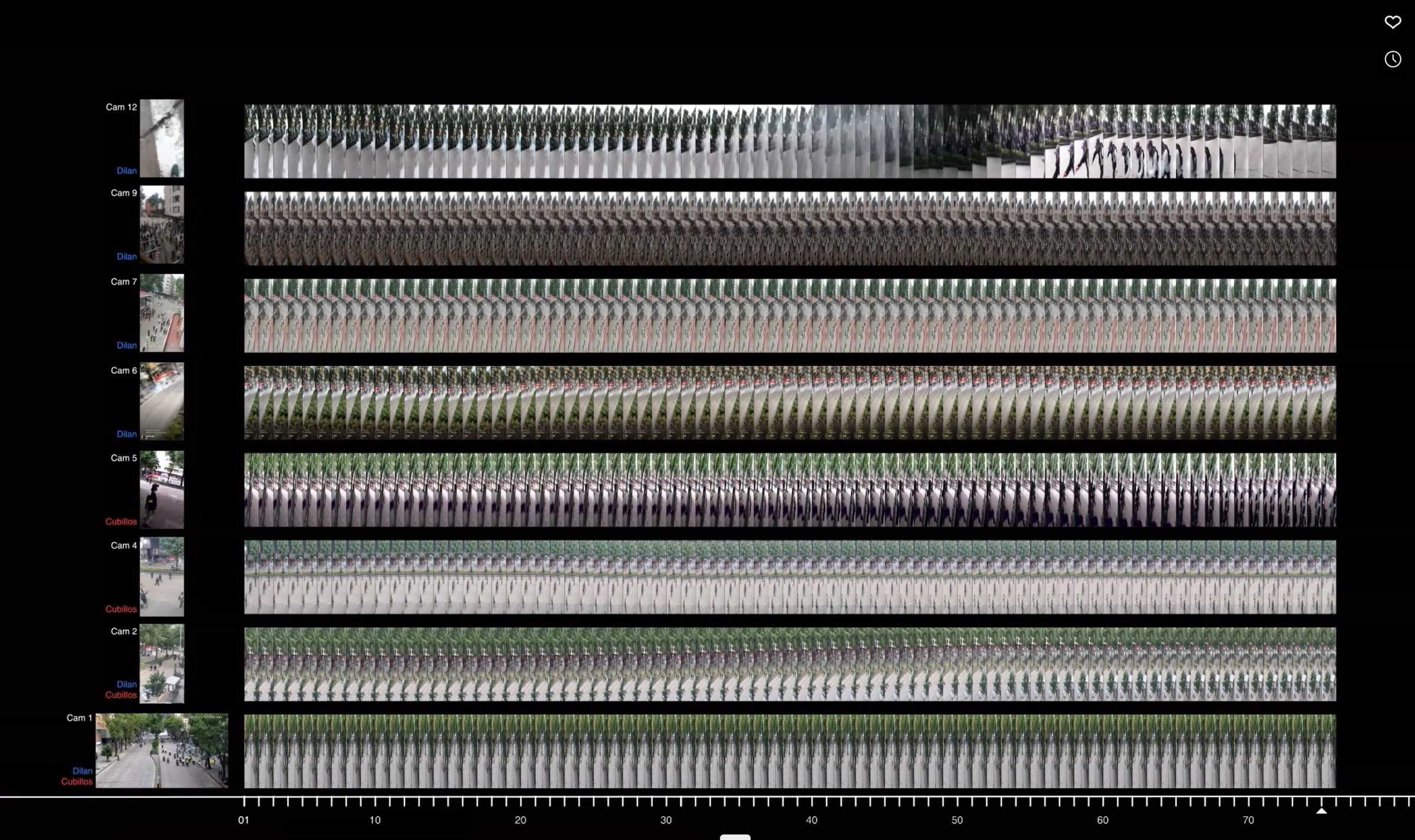
The cameras recorded the relationship between the motions of Cubillos and Dilan. As soon as Dilan launched the second tear gas canister, Cubillos stopped walking and changed his body position, indicating that something caught his attention. He then took four steps to the north before firing. We followed these four steps recorded across 47 frames and synchronised them with Dilan’s movement. During the first and second steps, Cubillos raised his weapon and aligned it with his target; during the third and fourth steps, he followed Dilan’s movements with the weapon. The fourth step ends with the shot, which is the most documented moment of the entire event.
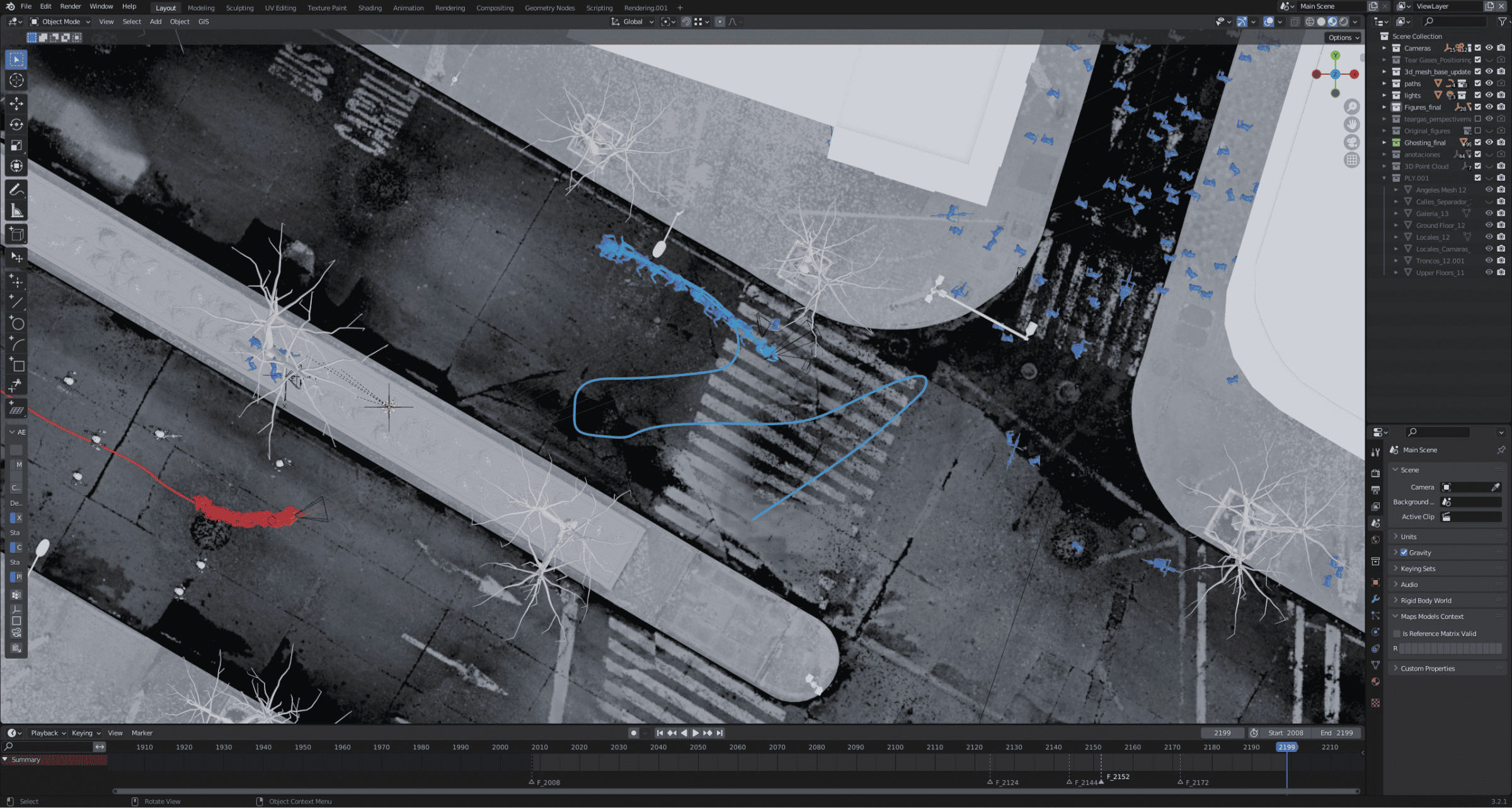
Our findings also refute CEVAP’s claim that the target of the shot was, as they term it, the ‘mob‘ behind Dilan. We highlight the lack of a methodological approach in analysing this so-called mob,— which CEVAP defines as a ‘sociological concept used to name a group of people that generates chaos in a disordered manner’. While this definition is both vague and problematic, CEVAP’s spatial analysis of the so-called mob is also imprecise. The location of potential targets is inconsistent, and there is moreover no spatial or video evidence to support the claim that anyone in this ‘mob’ was posing a threat.
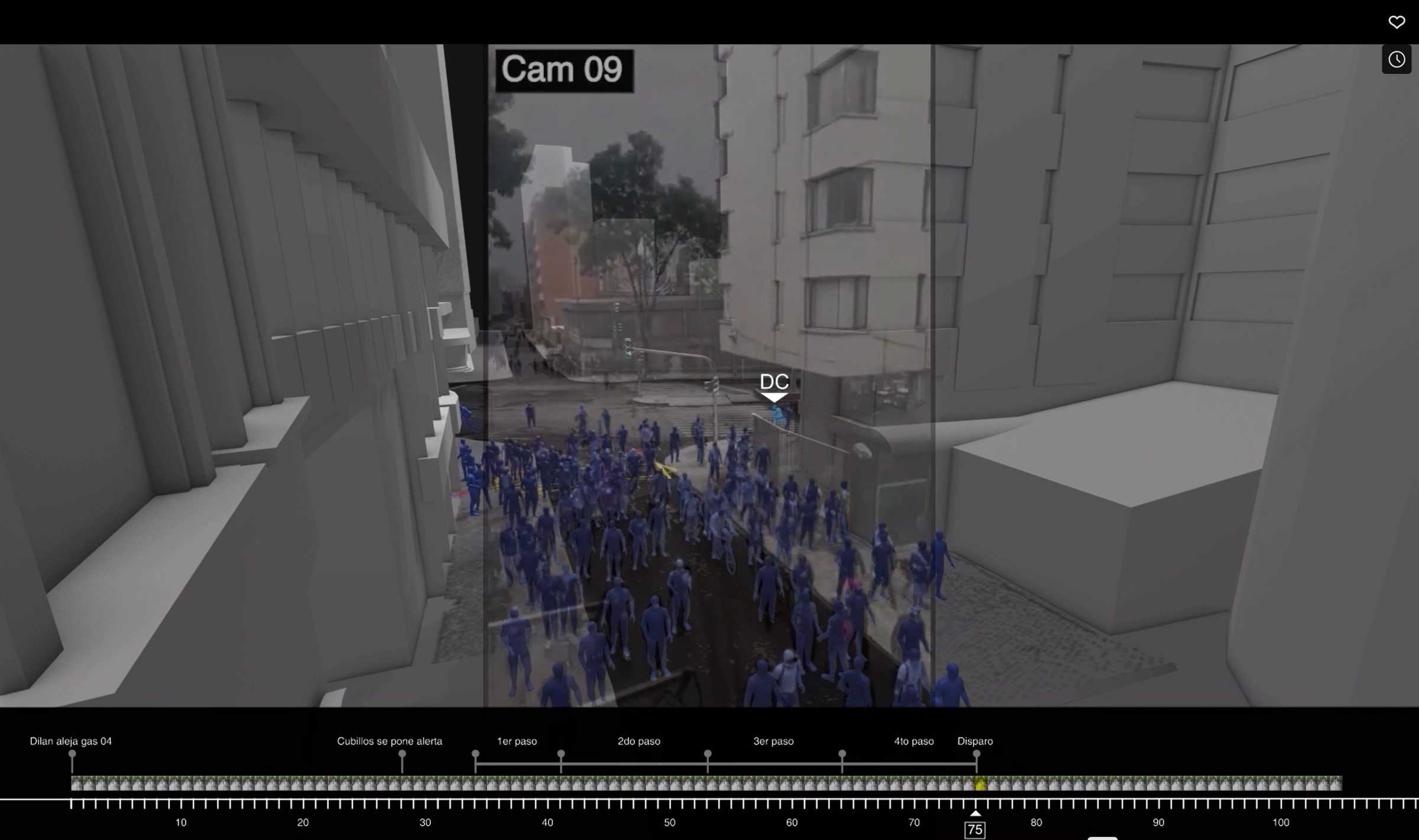
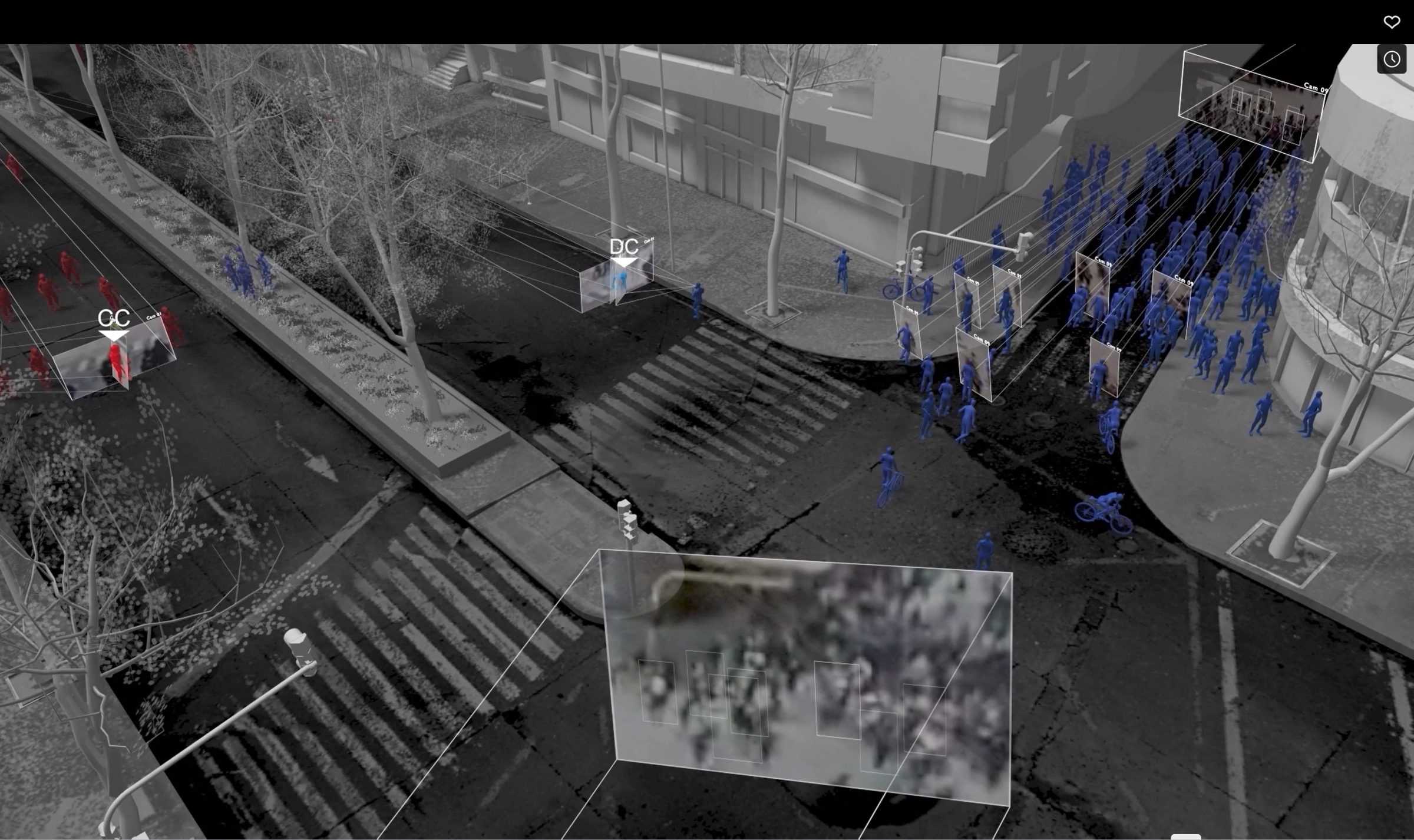
Taking all the available videographic evidence and 3D analysis into consideration, we conclude that Dilan was the most likely target of the shot, having been tracked with Cubillos’ weapon as soon as he returned a tear gas canister down Calle 19. CEVAP’s claims seem to present a contradiction: they claim that Dilan wasn’t the target of the shot, but at the same time state that he posed a threat to the police, therefore justifying the use of the non-lethal weapon. Our analysis counters both these claims, as they are made using inadequate methods of visual investigation.
This case was conducted by Forensic Architecture’s new research unit based in Bogotá, ‘Plano Negativo’. This investigation was made possible by the generous support of the Activism in Progress grant from the Center for Human Rights in the Arts at Bard College, our partners from the Comité de Solidaridad con presos políticos, and Porticus Foundation, who are also supporting the creation of this new research unit. We would also like to thank Lorenzo Morales from 070 for providing key research support during the investigation. Camera 02 and 05 were originally collected by 070 for their report.
Español
El 23 de Noviembre de 2019, en el marco de una de las olas de protesta antigubernamentales más grandes de las últimas décadas en Colombia, un agente del Escuadrón Móvil Antidisturbios le disparó al manifestante de 18 años Dilan Cruz, en la ciudad de Bogotá. El Paro Nacional en el que Dilan participaba estuvo motivado por las políticas conservadoras del Presidente de aquél momento, Ivan Duque, así como por sus falta de compromiso con el cumplimiento de los acuerdos de paz firmados en 2016 con la guerrilla FARC. Dilan fue impactado en la cabeza por una munición llamada bean bag -un tipo de munición que ha sido considerada como no letal o menos letal y es frecuentemente utilizada en protestas en todo el mundo. Sufrió trauma craneal severo y murió por esas heridas, dos días después, en el hospital.
El evento fue capturado por múltiples cámaras de testigos, periodistas y defensores de derechos humanos, así como una cámara de seguridad localizada en la carrera quinta con calle 19, en el centro de Bogotá. Estos videos fueron inicialmente analizados por varios medios de comunicación, incluyendo 070, Newsy, y Bellingcat, y Noticias Uno. Estos análisis identificaron al oficial que disparó a Dilan como el Capitán Manuel Cubillos. Sin embargo, fueron desacreditados por la Fiscalía General en el proceso de evaluación de la evidencia para el caso jurídico, con el argumento de que no tenían piezas visuales claves para apoyar sus conclusiones.
El Centro Estratégico de Evaluación Probatoria (CEVAP), responsable de realizar valoraciones técnicas de la evidencia, analizó el evento utilizando videos y un escaneo en 3D de la escena. Afirmaron que Dilan no era el objetivo previsto del disparo, citando la ausencia de evidencia. En cambio, concluyeron que el Capitán Cubillos disparó hacia una “turba” de manifestantes que representaban una amenaza para la policía, y que Dilan cruzó la línea de fuego destinada a neutralizar la llamada ‘turba’.
Nuestra investigación llega a la conclusión opuesta. Ubicamos los mismos videos usados por la Fiscalía, que hacen parte del caso jurídico, en un modelo tridimensional. Usamos una serie de métodos avanzados de análisis visual y espacial, que no permiten decir que hay más que suficiente evidencia visual que apoya la tesis de que Dilan -y no la “turba”- era el objetivo de Cubillos. Demostramos cómo el Capitán Cubillos siguió los movimientos de Dilan Cruz con su arma antes de disparar. La sincronización espacio-temporal del material audiovisual nos permitió establecer una relación entre el movimiento de Dilan y el de Capitán Cubillos mientras levanta su arma, una coreografía de movimientos donde Cubillos responde al movimiento de Dilan.
Nuestro método central de análisis es la reconstrucción digital del evento en 3 dimensiones. Situamos las cámaras en ese modelo y las utilizamos para reconstruir, tanto el movimiento como la posición de cada objeto y persona en el espacio construído y en los diferentes momentos del desarrollo del evento. Reprodujimos con detalle los movimientos de la policía, civiles y objetos, asegurando la precisión geo temporal basada en los registros videográficos.
Este método difiere sustancialmente del de CEVAP, qué afirmó haber realizado un análisis en 3D de la escena del crimen. Sin embargo, cuando nuestros investigadores solicitaron este análisis, la respuesta de la Fiscalía General fue que esta reconstrucción en 3D nunca se llevó a cabo, pues no era necesaria dado que existían los videos. En su lugar, utilizaron diagramas bidimensionales para ubicar a diferentes actores y objetos, basándose en capturas de pantalla de los videos. Esto llevó a un análisis inexacto e impreciso.
También analizamos las condiciones técnicas del registro audiovisual, un elemento central que el CEVAP no tuvo en cuenta al momento de realizar su trabajo. Factores como la distancia entre la lente y el objeto, el tipo de cámara y la perspectiva, influyen en lo que se registra y la forma en que se presenta como imagen. Segundos antes de que Cubillos le disparara a Dilan, él lanzó dos granadas lacrimógenas por la Calle 19. Utilizando la perspectiva de una sola cámara, que ellos determinaron como el principal objeto de evidencia visual, CEVAP concluyó que estas granadas cayeron muy cerca de un grupo de agentes del ESMAD, constituyendo una amenaza que autorizaba el uso de armas no letales.
Sin embargo, cuando situamos esta cámara en el modelo 3D y cruzamos su contenido con otras, pudimos medir la distancia de la granada lacrimógena respecto a los agentes del ESMAD. Descubrimos que el punto de caída estuvo a 27 metros de los agentes. Debido a que el CEVAP no tuvo en cuenta las condiciones técnicas de la grabación del evento y ni la interacción entre las diferentes perspectivas visuales, su análisis y comprensión del evento son insuficientes.
Intencionalidad
La segunda parte de la investigación analiza el momento del disparo. Examinamos los cuatro pasos que Cubillos dio antes de disparar su arma. Nuestro análisis de la relación entre los movimientos de Cubillos y Dilan durante estos pasos indica que Dilan fue el objetivo más probable del disparo.
La secuencia desde el momento en que Dilan devolvió la segunda granada lacrimógena hasta que Cubillos disparó su arma fue registrada por ocho cámaras en 75 cuadros, lo que equivale a dos segundos y medio. Cada cámara registró diferentes aspectos de la escena; cuatro cámaras capturaron a Dilan, dos a Cubillos y otras dos los grabaron a ambos.
Las cámaras registraron la relación entre los movimientos de Cubillos y Cruz. Tan pronto como Cruz lanzó la segunda granada lacrimógena Cubillos dejó de caminar y cambió su posición corporal, indicando que algo llamó su atención. Luego dio cuatro pasos hacia el norte antes de disparar. Seguimos estos cuatro pasos registrados en 47 cuadros y los sincronizamos con el movimiento de Dilan. Durante el primer y segundo paso, levantó su arma y la alineó con su objetivo; durante el tercer y cuarto paso, siguió los movimientos de Dilan con el arma. El cuarto paso termina con el disparo, que es el momento más documentado de todo el evento.
También refutamos la afirmación de CEVAP de que el objetivo del disparo era lo que ellos llaman la “turba” detrás de Dilan. Destacamos la falta de un enfoque metodológico y conceptual claro en el análisis de la “turba”. En el informe afirman que es un ‘concepto sociológico que se usa para nombrar un conjunto de personas que en forma desordenada genera confusión y caos,’ sin explicar de donde proviene tal definición o como es utilizada como categoría sociológica. El análisis espacial de esta “turba” es igualmente impreciso, La ubicación de los posibles objetivos en “la turba” es inconsistente y no existe evidencia espacial ni de video que respalde la afirmación de que alguien en esta “turba” representaba una amenaza.
Con base en la información videográfica y el análisis tridimensional, concluimos que Dilan fue el objetivo más probable y que fue seguido con el arma tan pronto como lanzó la granada lacrimógena por la Calle 19. Las afirmaciones de CEVAP parecen presentar una contradicción; afirman que Dilan no fue el objetivo del disparo, pero al mismo tiempo, representaba una amenaza para la policía, justificando el uso del arma no letal. Nuestro argumento contradice ambas afirmaciones, ya que se basan en métodos inadecuados de investigación visual.
Este caso fue llevado a cabo por la nueva unidad de investigación de Forensic Architecture con sede en Bogotá, llamada ‘Plano Negativo’. Esta investigación fue posible gracias al generoso apoyo de la beca Activism in Progress del Centro para los Derechos Humanos en las Artes de Bard College, nuestros socios del Comité de Solidaridad con presos políticos y la Fundación Porticus, quienes también apoyaron la creación de esta nueva unidad de investigación. También queremos agradecer a Lorenzo Morales de 070 por proporcionar un importante apoyo de investigación durante la investigación. Las cámaras 02 y 05 fueron originalmente recopiladas por 070 para su informe.
This investigation was supported in part by the OSUN Center for Human Rights & the Arts at Bard College.